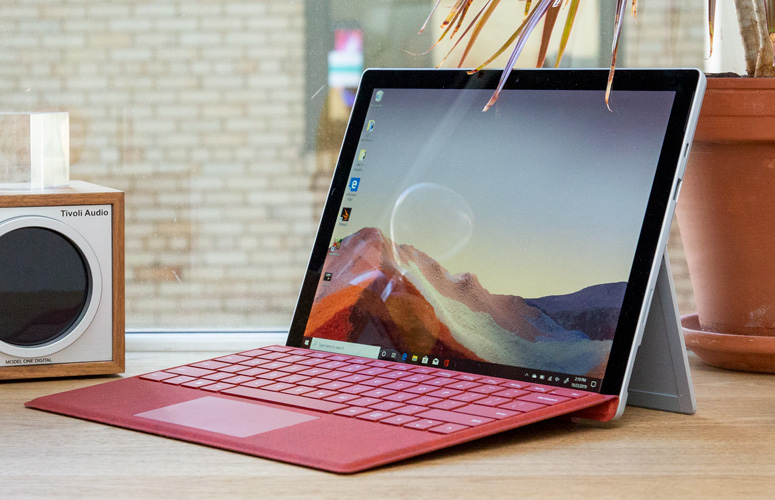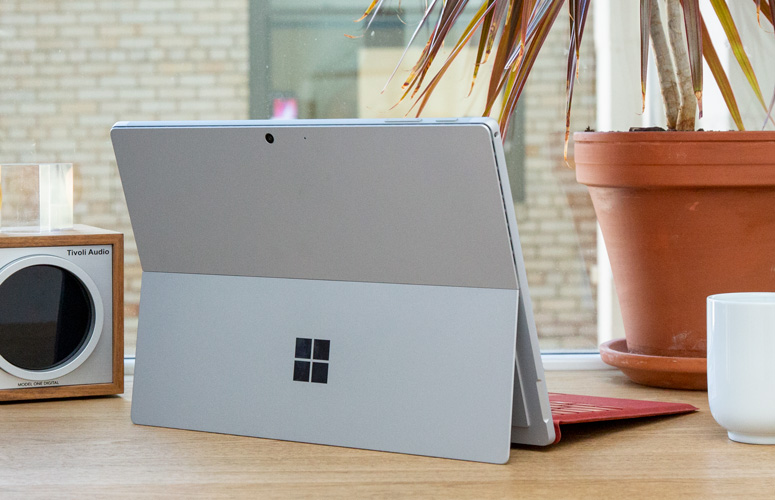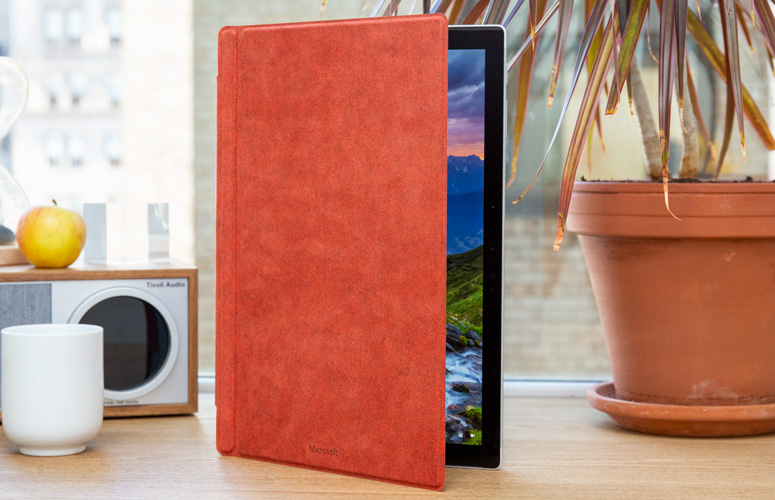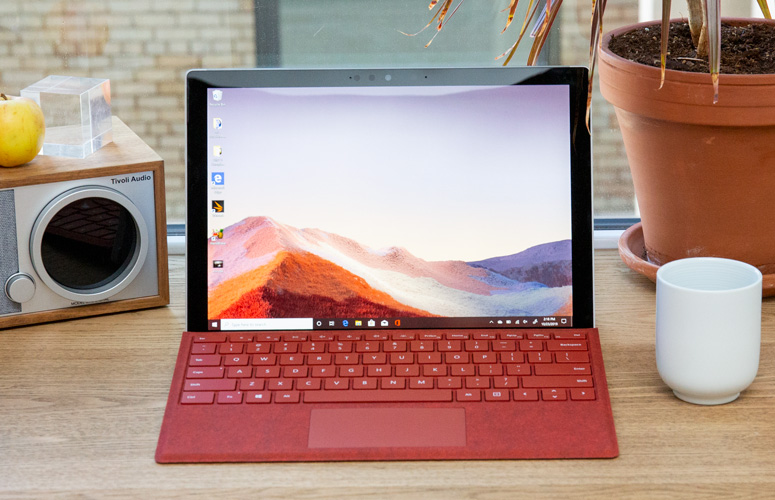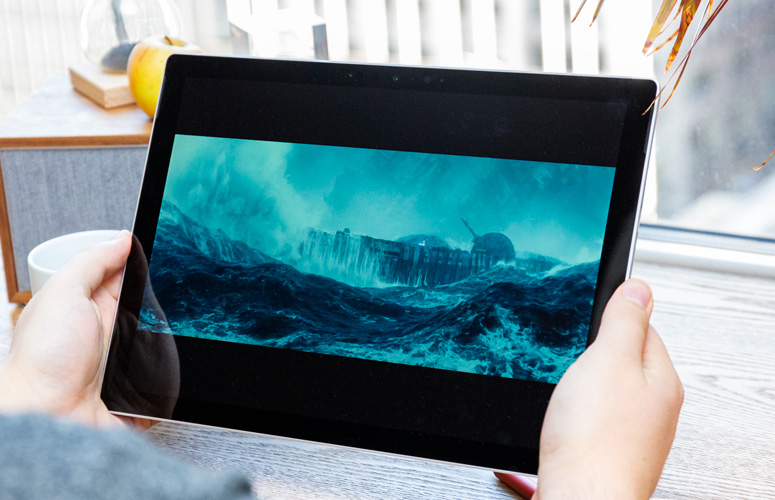Laptop Mag Verdict
Microsoft's Surface Pro 7 adds USB-C and 10th Gen CPUs, but those welcome additions come at a cost.
Pros
- +
Premium metal chassis
- +
Fast overall performance
- +
Bright, vivid display
- +
Comfortable keyboard
- +
Now with USB-C
Cons
- -
Keyboard and stylus sold separately
- -
Slow, expensive SSD
- -
Worse battery life than last year's model
Why you can trust Laptop Mag
The Surface Pro 7 ($749 starting; reviewed at $1,199) felt like an afterthought when Microsoft unveiled its latest fleet of Surface products. The lack of attention to this flagship tablet was in part because of the more exciting products Microsoft had on hand, like the Surface Pro X and the Surface Laptop 3.
Another reason is that the Surface Pro 7 is practically identical to its predecessor, the Surface Pro 6. Yes, Microsoft finally added a long-overdue USB-C port but it's not even the faster Thunderbolt 3 variety. And while 10th Gen Intel chips provide a nice performance boost to the Surface Pro 7, it comes at the expense of battery life.
The Surface Pro 7 is still one of the best 2-in-1 laptops thanks to its premium design, beautiful display and comfortable keyboard, but this latest convertible tablet is an unexciting iteration that takes two small steps forward and one large step backward.
Microsoft Surface Pro 7 price and configuration options
For $749, the base model Surface Pro 7 comes equipped with an Intel Core i3 CPU, 4GB of RAM and a 128GB SSD.
Microsoft still sells the Surface Pro 7's Surface Pro Type Cover ($129) and the Surface Pen ($99) separately, so you'll spend at least $878 to make the Surface Pro 7 a convertible and $977 for the full package.
If you have the extra cash, we recommend spending $899 on a model with an Intel Core i5 CPU, 8GB of RAM and a 128GB SSD. Adding the keyboard brings the total to $1,028, or $1,127 with the stylus.
Our $1,199 review unit is equipped with an Intel Core i5-1035G5 CPU, 8GB of RAM and a 256GB SSD (sadly, Microsoft charges $300 to go from 128GB to 256GB of storage). We also received the Signature Type Cover ($159) and the Surface Pen ($99), which brings the total package to $1,457.
Sign up to receive The Snapshot, a free special dispatch from Laptop Mag, in your inbox.
MORE: Which Surface Is Right for You? Pro X vs Pro 7 vs Laptop 3
Microsoft sells the same model with 16GB of RAM for $1,399 for the tablet only. If you need more power, you can buy a $1,499 configuration with a Core i7 CPU, 16GB of RAM and a 256GB SSD, or go for broke and pay $2,299 for the 1TB version.
Microsoft Surface Pro 7 design
The Surface Pro 7 keeps the same aesthetic ingredients of its predecessors. Despite all the praise we've given the design over the years, it's time for a new recipe.
Apart from a new USB-C port on the side, the Surface Pro 7 has the same minimalist aesthetic as the Surface Pro 6. Available in matte black and silver, the Surface Pro 7 is a slim magnesium slate with a shiny Microsoft logo on the rear kickstand.
That kickstand extends 165 degrees and allows you to prop the Surface Pro 7 into laptop or studio mode. The flap is easy to extend and firm enough to keep the tablet propped up.
Apart from a new USB-C port on the side, the Surface Pro 7 has the same minimalist aesthetic as the Surface Pro 6.
It's a good solution for turning a tablet into a laptop but I hope Microsoft can craft a more elegant mechanism in the coming years. For now, you have to extend the kickstand manually, which isn't as easy as lifting the lid of a laptop. Also, the Surface Pro 7 bounces around when you use the kickstand on your lap.
At the very least, Microsoft could have trimmed the Surface Pro 7's bezels, which would have gone a long way to modernize this aging design. Unveiling the Surface Pro 7 alongside the sleek Surface Pro X showed just how dated the former looks.
At 0.3 inches thin and 1.7 pounds (2.4 pounds with the keyboard attached), the Surface Pro 7 is the same size as its predecessor but bigger than the 12.9-inch Apple iPad Pro (0.2 inches, 1.4 pounds).
Microsoft Surface Pro 7 ports
It's not Thunderbolt 3 but we're happy to see the Surface Pro 7's USB-C port, regardless. Other than that future-proof edition, the Surface Pro 7 has the same connections as its predecessor; You'll find a USB 3.1 Type-A and magnetic Surface Connect port (for charging) next to the USB-C input on the right side.
On the left side is a headphone jack while a microSD card slot hides behind the Surface Pro 7's kickstand.
Microsoft Surface Pro 7 display
I enjoyed watching videos on the Surface Pro 7's 12.3-inch, 2736 x 1824-resolution PixelSense touch screen. Not only is the panel detailed and fairly vivid but it also gets superbright.
Christian Bale's indigo-blue Ford GT40 race car shimmered on the saturated panel as it sped around a track in pursuit of its blood-red Italian rival in the trailer for Ford v Ferrari. In a high-speed crash scene, the high-res panel was so detailed that I could see pieces of debris and chunks of soil shooting into the air. I'm a stickler for accurate white balance so I was happy to see crisp, clean white backgrounds as I visited my favorite websites.
Those who don't plan on buying the detachable keyboard or a mouse will be relieved to hear that the Surface Pro 7's touch screen is very responsive. There wasn't any lag or missed taps as I browsed the web using my fingers and the optional Surface Pen.
In a high-speed crash scene, the high-res panel was so detailed that I could see pieces of debris and chunks of soil shooting into the air.
According to our colorimeter, the Surface Pro 7's display covers 102% of the sRGB color gamut, which surprised me given how saturated the colors look. Competing devices have more vivid panels, including the 12.9-inch iPad Pro (128.4%) and the XPS 13 2-in-1 (113%). Even the displays on the Surface Pro 6 (136%) and the average premium laptop (130%) offer a wider range of colors.
It could be that the panel's exceptional brightness, at 395 nits, is what makes the colors pop so much. Even so, the screens on the Surface Pro 6 (408 nits), the Apple iPad Pro (484 nits) and the XPS 13 2-in-1 (516 nits) get even brighter. On a positive note, the Surface Pro 7's panel is brighter than the category average (347 nits).
Microsoft Surface Pro 7 audio
The dual front-firing speakers on the Surface Pro 7 can fill a medium-size room with detailed, undistorted audio. There was a nice energy to The Killers' "Mr. Brightside," with the speakers doing a good job of separating the electric guitar so that Brandon Flowers' voice could take center stage. I was also impressed by the thudding bass line in Jay-Z's "No Church in the Wild," even if it lacked the low rumble I optimistically hoped for. For that deep base sound, consider buying a good pair of noise-canceling headphones.
Microsoft Surface Pro 7 keyboard and touchpad
I'm relieved that Microsoft didn't make any major changes to the Surface Pro 7's excellent (but pricey) Signature Surface Type Cover keyboard and confident in saying that this is the best detachable keyboard by some margin.
The Type Cover's backlit keys are large, well-spaced and offer surprisingly deep travel. And if you spend extra on the Signature version that Microsoft sent us, you also get a warm, soft Alcantara fabric surface to rest your palms on.
My favorite thing about the keyboard is how effortlessly my fingers bounced among the letters thanks to the clickiness of the keys. I'm also a big fan of the Poppy Red version Microsoft sent us and can't wait to see the new Ice Blue look in person.
I also never worried about the keyboard coming detached from the tablet. The accessory snaps into the bottom of the Surface Pro 7, with strong magnets keeping it in place.
My favorite thing about the keyboard is how effortlessly my fingers bounced among the letters thanks to the clickiness of the keys.
The Type Cover keyboard's glass touchpad is great for productivity and gives the Surface Pro 7 a leg up on the iPad Pro. My fingers appreciated the smooth, soft coating on the 4 x 2.1-inch touchpad, and I had no problems executing Windows 10 gestures, like pinch-to-zoom or two-finger scrolling.
Microsoft Surface Pro 7 pen
Microsoft charges $99 for the optional Surface Pen. We recommend splurging on the accessory if you need to take hand-written notes, draw pictures or do precise video or photo-editing. Of the styli we've tested, the Surface Pen is among the best.
The Surface Pen's loaded list of features includes 4,096 pressure points, tilt for shading, a magnet that attaches to the side of the Surface Pro 7, and a rubber piece on the back for erasing.
The thick stylus was very comfortable to hold and I didn't notice any lag when sketching an arcane cat drawing. Again, Microsoft nailed the metallic red color on the pen's aluminum chassis.
MORE: 10 Great Pen-Enabled Apps That Work with Windows Ink
Still, I do wish the Surface Pen used wireless charging technology like the Apple Pencil instead of a non-rechargeable AAAA battery.
Microsoft Surface Pro 7 performance
Apart from a few minor changes, the Surface Pro 7 is, essentially, a Surface Pro 6 with updated 10th Gen Intel Core chips.
Our unit was equipped with an Intel Core i5-1035G4 CPU and 8GB of RAM. If you're not familiar with Intel's confusing new processor-naming scheme, Microsoft is using the new 10-nanometer Ice Lake chips, not the 14-nanometer Comet Lake variant. The verdict is still out on which processor family offers better performance. Regardless, the Surface Pro 7 loaded 16 Google Chrome tabs without the slightest hint of lag, even as I streamed four 1080p videos.
The Surface Pro 7 scored an impressive 17,225 on the Geekbench 4.1 overall performance test, coming in just short of the iPad Pro (17,995, A12X Bionic). Just as we'd hoped, the Surface Pro 7 is notably faster than the Surface Pro 6 (13,761, Core i5-8250U), although it couldn't quite catch the XPS 13 2-in-1 (18,684) running on a Core i7-1065G7 CPU.
MORE: The Laptops with the Best CPU Performance: Guide
Microsoft needs to use faster hard drives in its Surface products or at least stop charging so much to upgrade storage capacity. The Surface Pro 7's 256GB SSD took 19 seconds to duplicate 4.97GB of multimedia files, which equates to a transfer rate of 267.9 megabytes per second. That's only a tad faster than the Surface Pro 6's sluggish SSD (203 MBps) and falls far behind the XPS 13 2-in-1 (463 MBps) and the category average (500.4 MBps)
Unfortunately, we've had some trouble running some of our other benchmark tests on the new 10th Gen chips. It took anywhere between 23 minutes and 40 minutes for the Surface Pro 7 to convert a 4K video to 1080p resolution. We saw the same inconsistent results on the XPS 13 2-in-1 and are currently in contact with Intel to see if it has to do with Ice Lake processors. For context, the Surface Pro 6 completed the task in 23 minutes and 22 seconds, which is right around the category average (22:36).
Microsoft Surface Pro 7 graphics
The integrated Iris Plus graphics in Intel's Ice Lake processors promise improved performance over what we've seen in 8th Gen chips. Our benchmarks haven't been able to prove that claim.
The Surface Pro 7 couldn't run the 3DMark Ice Storm Unlimited benchmark we typically use to test graphics performance. There seems to be a compatibility issue with the chip because the Ice Lake CPU-equipped XPS 13 2-in-1 also had problems running this test.
MORE: The Best Surface Pro Alternatives (Many of Them Are Less Expensive)
Our real-world gaming evaluation wasn't much better; The racing game Dirt 3 ran at only 36 frames per second on the Surface Pro 7. While that tops our 30-fps playability threshold, the Surface Pro 6 (81 fps) and the average premium laptop (61 fps) can play the game at much higher frame rates. There could be some optimization problems for Dirt 3 given that the XPS 13 2-in-1 (42 fps) also struggled with the benchmark, so we'd take these results with a grain of salt for now.
Microsoft Surface Pro 7 battery life
Well, this is disappointing. The Surface Pro 7 lasted only 7 hours and 52 minutes on our battery test, which involves continuous web surfing over Wi-Fi at 150 nits of brightness. That's nearly 1.5 hours shorter than the Surface Pro 6's (9:20) runtime and worse even than the iPad Pro (13:14) and the XPS 13 2-in-1 (10:57). The Surface Pro 7 couldn't even match the category average (8:14).
MORE: Laptops with Best Battery Life - Longest Lasting Laptop Batteries
Microsoft Surface Pro 7 webcam
I never thought I'd see the day: finally, a Windows 10 device that doesn't need an external webcam. The Surface Pro's 5-megapixel front-facing webcam produces sharp, colorful images that are virtually free of noise.
I could clearly see individual strands of hair in my beard in a selfie I snapped in our dimly lit office. From the greenish-blue tones in my eyes to my faded red shirt, the camera produced punchy, accurate colors. Even the lights hanging over my head were properly exposed.
The 8MP camera on the rear of the Surface Pro 7 is hit-or-miss. The lens accurately captured the subtle purple colors in a photo of flowers I snapped outside the New York City Public Library. Unfortunately, the camera really struggled with exposure and cast an unpleasant yellowish hue over the library's facade.
The front-facing camera supports Windows Hello login using facial recognition. Setup was super simple -- just place your face within a frame and wait a few seconds -- and the camera quickly and reliably logged me into the tablet.
Microsoft Surface Pro 7 software and warranty
Microsoft didn't add any additional software on the Surface Pro 7 that isn't already included with Windows 10 Home. That said, you still get the standard set of bloatware apps found on Windows devices, including Farm Heroes Saga, Microsoft Solitaire Collection and Netflix.
The Surface Pro 7 includes a one-year limited warranty. See how Microsoft fared in our Best and Worst brands and Tech Support Showdown special reports.
Bottom line
Microsoft's convertible remains the best option on the market for those who want the portability of a tablet combined with the convenience of a laptop. But the Surface Pro 7 does little to move the needle. The few new things it brings to the table -- USB-C and 10th Gen processors -- are certainly welcome but not enough to make the Surface Pro 7 a required upgrade if you already own the Surface Pro 6.
In some ways, the Surface Pro 7 is even a downgrade from its predecessor; the battery life of this year's tablet is about 1.5 hours worse than the Surface Pro 6's and the screen on the newer model isn't as vivid, either.
If you're turned off by these drawbacks, Apple's 12.9-inch iPad Pro offers similar performance to the Surface Pro 7 but better battery life in a sleeker chassis. You could also find a deal on the Surface Pro 6, which gets you almost everything the Surface Pro 7 offers but even better battery life. If you want a hybrid but aren't sold on tablets, the Dell XPS 2-in-1 is our favorite laptop convertible.
All things considered, the Surface Pro 7 remains at the top of its class but is overdue for a proper overhaul.
- Best and Worst Laptop Brands
- The Best Laptops for Business and Productivity
- The Best Laptops for Every Need
Microsoft Surface Pro 7 Specs
| Bluetooth | Bluetooth 5.0 |
| Brand | Microsoft |
| CPU | Intel Core i5-1035G4 |
| Card Slots | microSD |
| Company Website | https://www.microsoft.com/en-us/ |
| Display Size | 12.3 |
| Graphics Card | Intel Iris Plus Graphics |
| Hard Drive Size | 256GB |
| Hard Drive Type | SSD |
| Highest Available Resolution | 2736 x 1824 |
| Native Resolution | 2736 x 1824 |
| Operating System | Windows 10 Home |
| Ports (excluding USB) | Headphone/Mic, microSD, Surface Connect, USB 3.1, USB Type-C |
| RAM | 8GB |
| RAM Upgradable to | 16GB |
| Size | 12.5 x 7.9 x 0.3 inches |
| Touchpad Size | 4 x 2.1 inches |
| USB Ports | 2 |
| Warranty/Support | one-year limited warranty |
| Weight | 1.7 pounds (2.4 with case) |
| Wi-Fi | 802.11ax |
| Wi-Fi Model | Intel Wi-Fi 6 AX201 |
Phillip Tracy is the assistant managing editor at Laptop Mag where he reviews laptops, phones and other gadgets while covering the latest industry news. After graduating with a journalism degree from the University of Texas at Austin, Phillip became a tech reporter at the Daily Dot. There, he wrote reviews for a range of gadgets and covered everything from social media trends to cybersecurity. Prior to that, he wrote for RCR Wireless News covering 5G and IoT. When he's not tinkering with devices, you can find Phillip playing video games, reading, traveling or watching soccer.
